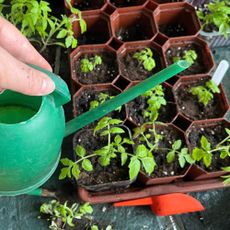Globeflower Care: Growing Globeflowers In The Garden


If you're looking for something a little different that not everyone has in the garden, you may want to look at members of the plant genus Trollius. Globeflower plants are not commonly found in the perennial garden, although you may find them growing in bog gardens or near a pond or stream. While they have a reputation for being difficult, growing globeflowers is not complicated if they are planted in the right place and you practice the correct globeflower care. You may be wondering, "What are globeflowers?" Trollius globeflower plants, members of the Ranunculaceae family, are striking perennial wildflowers that bloom in spring. Shaped like a ball, a goblet, or a globe, flowers in the garden bloom on stems rising above the foliage in shades of yellow and orange. Finely textured foliage of growing globeflowers has a mounding habit. These plants grow happily near a pond or in a damp woodland in USDA plant hardiness zones 3 through 7. Properly located globeflowers in the garden reach 1 to 3 feet (31-91 cm.) in height and spread to 2 feet (61 cm.).
Types of Growing Globeflowers
Several cultivars of globeflowers are available.
- For those without a pond or bog garden, T. europaeus x cultorum, the common globeflower hybrid 'Superbus,' performs in soils that are less than consistently moist.
- T. ledebourii, or Ledebour globeflower, reaches 3 feet (91 cm.) in height with vigorous, orange blooms.
- T. pumilus, the dwarf globeflower, has yellow blossoms that take on a flat shape and grows to only a foot (31 cm.) tall.
- T. chinensis 'Golden Queen' has large, ruffled blooms that appear as late as May.
Globeflower Care
Globeflowers in the garden are best started from cuttings or by purchasing a young plant, as seeds can take up to two years to germinate. Ripe seeds from growing globeflowers germinate best, if you decide to try this method. In the right location, globeflowers may re-seed. Taking care of Trollius globeflower plants is simple once you provide them with the right location. Globeflowers in the garden need a full sun to part shade location and moist soil. These flowers are suited to rocky areas where soil is fertile and stays moist. Globeflowers perform well as long as they aren't allowed to dry out and are not subjected to extreme heat from scorching summer temperatures. Deadhead spent flowers for the possibility of more blooms. Trim back the plant's foliage when blooming has stopped. Divide in spring as soon as growth begins. Now that you know "What are globeflowers," and the simplicity of their care, you may want to add them to that moist, shady area where nothing else will grow. Provide adequate water and you can grow the showy blooms nearly anywhere in your landscape.
Gardening tips, videos, info and more delivered right to your inbox!
Sign up for the Gardening Know How newsletter today and receive a free copy of our e-book "How to Grow Delicious Tomatoes".

Becca Badgett was a regular contributor to Gardening Know How for ten years. Co-author of the book How to Grow an EMERGENCY Garden, Becca specializes in succulent and cactus gardening.
-
 How To Grow A Cut Flower Container Garden – For Gorgeous Fresh Blooms Even In Small Spaces
How To Grow A Cut Flower Container Garden – For Gorgeous Fresh Blooms Even In Small SpacesCut flower cultivation may bring to mind tall, statuesque plants in beds and borders – but you can also grow a cut flower container garden for bold blooms in smaller spaces
By Tonya Barnett
-
 How Often To Water Seedlings? The Best Schedule For Healthy Growth
How Often To Water Seedlings? The Best Schedule For Healthy GrowthLearn how much to water seedlings at every stage of the growing process – from germination to transplanting in the garden – plus the best methods for success.
By Teo Spengler